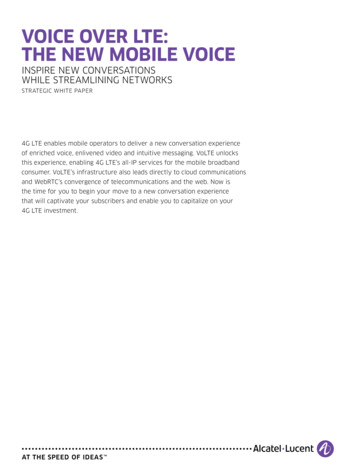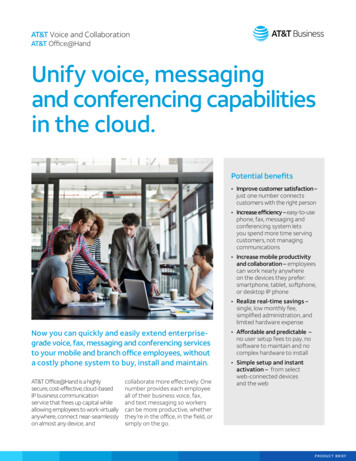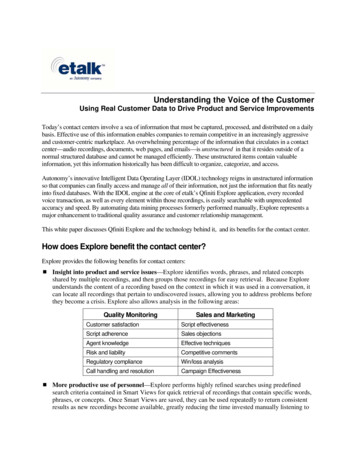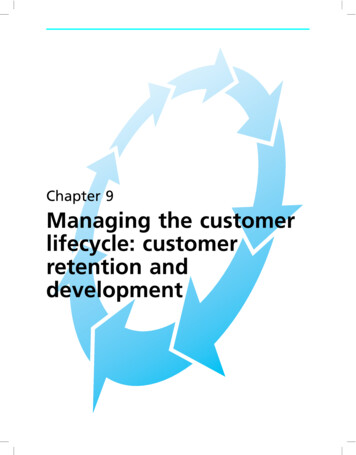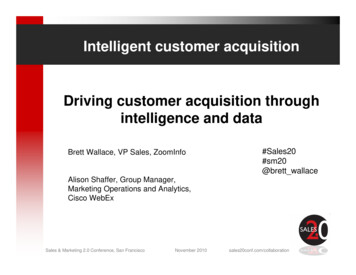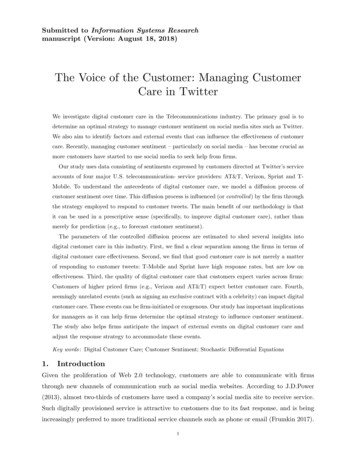
Transcription
Submitted to Information Systems Researchmanuscript (Version: August 18, 2018)The Voice of the Customer: Managing CustomerCare in TwitterWe investigate digital customer care in the Telecommunications industry. The primary goal is todetermine an optimal strategy to manage customer sentiment on social media sites such as Twitter.We also aim to identify factors and external events that can influence the effectiveness of customercare. Recently, managing customer sentiment – particularly on social media – has become crucial asmore customers have started to use social media to seek help from firms.Our study uses data consisting of sentiments expressed by customers directed at Twitter’s serviceaccounts of four major U.S. telecommunication- service providers: AT&T, Verizon, Sprint and TMobile. To understand the antecedents of digital customer care, we model a diffusion process ofcustomer sentiment over time. This diffusion process is influenced (or controlled ) by the firm throughthe strategy employed to respond to customer tweets. The main benefit of our methodology is thatit can be used in a prescriptive sense (specifically, to improve digital customer care), rather thanmerely for prediction (e.g., to forecast customer sentiment).The parameters of the controlled diffusion process are estimated to shed several insights intodigital customer care in this industry. First, we find a clear separation among the firms in terms ofdigital customer care effectiveness. Second, we find that good customer care is not merely a matterof responding to customer tweets: T-Mobile and Sprint have high response rates, but are low oneffectiveness. Third, the quality of digital customer care that customers expect varies across firms:Customers of higher priced firms (e.g., Verizon and AT&T) expect better customer care. Fourth,seemingly unrelated events (such as signing an exclusive contract with a celebrity) can impact digitalcustomer care. These events can be firm-initiated or exogenous. Our study has important implicationsfor managers as it can help firms determine the optimal strategy to influence customer sentiment.The study also helps firms anticipate the impact of external events on digital customer care andadjust the response strategy to accommodate these events.Key words : Digital Customer Care; Customer Sentiment; Stochastic Differential Equations1.IntroductionGiven the proliferation of Web 2.0 technology, customers are able to communicate with firmsthrough new channels of communication such as social media websites. According to J.D.Power(2013), almost two-thirds of customers have used a company’s social media site to receive service.Such digitally provisioned service is attractive to customers due to its fast response, and is beingincreasingly preferred to more traditional service channels such as phone or email (Frumkin 2017).1
Title: Social Media Customer CareArticle to be submitted to Information Systems Research; (Version: August 18, 2018)2Firms too have an incentive to embrace service provision through social media. According to Hyken(2016), the average cost of a service-related response in Twitter is 1, while the average cost ofinteracting with a customer through a traditional call center can be close to 6. Firms that useTwitter as a social care channel are seeing a large 19% increase in customer satisfaction. Given thatdigital customer care has mutual benefits for firms and customers, it is not surprising to observea 250% increase in customer service interactions over Twitter during the past few years (Frumkin2017).Although there are significant benefits of digital customer care management, it imposes certainchallenges. The communication between firms and customers is public. Therefore, a firm’s responseto a customer’s query could impact not only the focal customer but also other existing and potentialcustomers. This, of course, can also be regarded as a key benefit of digital customer care, namely,that a response to one customer could potentially benefit other customers. However, it is importantfor firms to devise a response strategy that adequately addresses customers’ queries in social media.Gunarathne et al. (2017) show some evidence that firms strategically respond to customers’ queries.In particular, their study suggests that firms tend to provide a more satisfactory response tocustomers who are more influential in social networking websites.Numerous examples in Twitter provide evidence that a failure to promptly respond to customerson social media may prove disastrous. For instance when British Airways had an eight-hour delayin responding to a dissatisfied customer, it made the customer’s tweet go viral, rapidly disseminating negative sentiment about the airline. The ineffective response not only aggravated thefocal customer, but also made the treatment observable to other social media users (social mediabystanders). In another example, American Airline responded with an automated “Thank You forYour Support” tweet to a Twitter user’s negative tweet, giving the impression that the airline’sresponses are perfunctory and automatic, rather than carefully constructed to resolve customers’problems (Burke 2016).These examples, along with many others, indicate that customers will continue to use socialmedia channels to communicate with firms, and it is up to firms to respond effectively. According to J.D.Power (2013), “consumer expectations for social interactions vary across industries,although quality content and responsive service representatives are keys to higher satisfaction levels.” Therefore, we explore the question: What is an optimal response strategy for digital customercare management?To answer this question, we develop a controlled diffusion model of customer sentiment. Thismodel is a Stochastic Differential Equation (SDE) that describes the dynamics of customer sentiment driven by the response strategy used by the firm. The control objectives of the firm areexplicitly modeled to capture how a firm should optimally react to customer sentiment. We recover
Title: Social Media Customer CareArticle to be submitted to Information Systems Research; (Version: August 18, 2018)3the parameters of this controlled diffusion process using Maximum Likelihood Estimation (MLE)and data on social media customer care. This data was collected from Twitter’s service accounts ofthe Big Four telecommunications firms in the U.S. (AT&T, Verizon, Sprint, and T-Mobile). Sentiment analysis was used to measure customer sentiment over time for each firm during a four-monthperiod. To lend credibility to our structural model, we compared the predictive performance ofthe diffusion model with state-of-the-art forecasting methods and found that our proposed modeloutperforms these models.The main advantage of our approach is not just in its predictive ability, but that it can prescribean optimal response strategy for effective digital customer care management. There are severaluseful insights gleaned from this study. First, we find that there is a clear separation among thefirms in terms of digital care effectiveness. The top two firms in the industry (AT&T and Verizon)do better – in terms of the effectiveness of care support – than Sprint and T-Mobile. Second, forall firms, we find that good digital care consists not merely of responding to tweets, but an effortintensive activity where customer tweets need to be carefully examined and adequately addressed.Third, customers expect better quality of care from firms that charge more for similar cellularplans. Fourth, because of its structural nature, our methodology allows us to estimate the impactof seemingly unrelated events that could significantly affect customer care (e.g. signing an exclusivecontract with a celebrity can improve how customers perceive the quality of care). Our findingsin that regard are that events external to the care platform (whether firm initiated or exogenous)can profoundly influence different aspects of digital customer care. Finally, we develop a closedform approximation of the optimal response strategy to effectively manage customer sentiment andrecover useful structural properties of such a strategy.The rest of the paper is organized as follows. We first provide a review of related work, followedby a discussion of a controlled diffusion model of how customer sentiment evolves over time. Wenext estimate the parameters of this controlled diffusion process using Twitter data from theservice handles of four major telecommunications service providers in the U.S. (AT&T, Verizon,T-Mobile, and Sprint). The estimated model is validated by comparing its out-of-sample predictiveperformance with that of state-of-the-art prediction models. We next provide several insights intothe nature of digital customer care in the telecommunications industry using a number of policysimulations and real events. Then we further explore the structure of the optimal digital customercare policy. We conclude the paper with a discussion and summary of the findings.2.Literature ReviewIn this section, we review the literature on firm-level impacts of customer sentiment as well as themain methodology employed in this study.
Title: Social Media Customer CareArticle to be submitted to Information Systems Research; (Version: August 18, 2018)42.1.Customer SentimentA basic premise of this study is that customer sentiment can be measured and is important tomanage for a firm. Customer sentiment can be gauged using sentiment analysis which is defined as“the field of study that analyzes people’s opinions, sentiments, evaluations, appraisals, attitudes,and emotions towards entities such as products, services, organizations, individuals, issues, events,topics, and their attributes.” (Liu 2015). A variety of studies in business-related domains find astrong relationship between customer sentiment and firm-level outcomes. Luo et al. (2013) reportthat social media-based metrics such as web blogs and consumer ratings are significant indicatorsof firm equity value. Goh et al. (2013) find that compared to user-generated content in brandcommunities, marketer-generated content has a weaker impact on consumer purchasing behavior.An effective way to influence customer sentiment is to use expert testimonies. In a study by Luoet al. (2017) sentiments expressed by experts on blogs are found to positively influence consumerperceptions of the focal brand. Lau et al. (2012) report that domain-specific sentiment analysiscan be used to make more informed decisions about business mergers and acquisitions. Customersentiment is not just an individual expression, but also a social phenomenon. Forman et al. (2008)report that online community members rate reviews containing identity-descriptive informationmore positively, and the prevalence of reviewer disclosure of identity information is associatedwith increases in subsequent online product sales. Lak and Turetken (2017) provide support forthe positive impact of sentiment scores on the efficiency of purchase decisions (time to make apurchase decision), but do not consider its role to be influential in increasing decision effectiveness(customer’s confidence in the purchase decision). Finally, Archak et al. (2011) report that textualdata can be used for the predictive modeling of future sales.Table 1 summarizes several studies, topics, and main findings in this area. These studies suggest that customer sentiment could influence firm equity value, branding activities, merger andacquisition decisions, and product sales and purchase decisions. Although these studies suggest theimportance of customer sentiment for firm success, they do not prescribe any systematic strategyto manage or influence customer sentiment. Our study intends to fill the gap, namely, to studyresponse strategies to manage customer sentiment within social media sites such as Twitter.2.2.Digital Customer CareLike any other business function, customer service operations have also been impacted by thedigital transformation. According to Bianchi et al. (2014), roughly 70% of the customers use onlineplatforms to purchase telecommunications-related products and services, and almost 90% of thecustomers use online platforms for customer service inquiries. Digital care platforms includingsocial media websites, have empowered customers to express their opinions about firms and their
Title: Social Media Customer CareArticle to be submitted to Information Systems Research; (Version: August 18, 2018)Table 1Study5Summary of Representative Studies Related to Customer Sentiment.TopicLuo et al. (2013)Social Media & Firm EquityValueGoh et al. (2013)Social Media Brand Community& Consumer BehaviorLuo et al. (2017)Expert Blogs’ Impacts on Consumer Perceptions of CompetingBrandsLau et al. (2012)Adaptive Decision Support forBusiness Mergers and AcquisitionsForman et al. (2008)The Relationship Between Consumer Reviews and ProductSalesLak and Turetken (2017)The Impact of Sentiment Scoreson Purchase DecisionsArchak et al. (2011)Product Features and ConsumerReviewsMain FindingsSocial media-based metrics such as webblogs and consumer ratings are significant,leading indicators of firm equity value.Compared to user-generated content inbrand communities, marketer-generatedcontent has a weaker impact on consumerpurchasing behavior.Expert blog sentiments and volume on afocal brand have a positive relationshipwith consumer perceptions of the focalbrand.Domain-specific sentiment analysis can beused to make more informed decisionsabout business mergers and acquisitions.Online community members rate reviewscontaining identity-descriptive informationmore positively, and the prevalence ofreviewer disclosure of identity informationis associated with increases in subsequentonline product sales.Sentiment scores improve the efficiency(speed) of purchase decisions without significantly affecting decision effectiveness(confidence).Textual data can be used for predictivemodeling of future changes in sales.products and services. Customers can take advantage of these platforms to seek better and fasterresponse from firms. An important survey published by The Institute of Customer Service (2013),reported that one undeniable impact of the digital customer service was that customers expectbetter service from firms. According to the same report, although “the percentage of customerswho experienced a problem has decreased from 17% in January 2008 to 11.7% in July 2012, theproportion of those went on to make a complaint rose from 72% to 76% in the same period.” Maet al. (2015) suggest that customers decry or complement a firm on social media depending ontheir relationship with the firm (negative, neutral, or positive). Furthermore, interventions madeby firms to modify firm-customer relationships often encourage further complaints in future.The majority of academic and practitioner publications assert that digital care platforms have alot to offer to firms. For instance, firms can lower their cost of providing customer service throughthe effective use of digital care platforms (Bianchi et al. 2014). Firms can also encourage experiencedcustomers to support more novice customers (Lithium Technologies Inc. 2017). Finally, customersatisfaction on digital platforms appears to be higher than the same on traditional channels suchas phone and mail (Bianchi et al. 2014).
Title: Social Media Customer CareArticle to be submitted to Information Systems Research; (Version: August 18, 2018)62.3.Stochastic Differential EquationsIn this study, we develop a Stochastic Differential Equation (SDE) model of the dynamics of theonline customer sentiment in the presence of a response strategy used by the firm. StochasticDifferential Equation has been applied in finance to model the time series of stock price movements,where randomness is inevitable (Black and Scholes 1973). A stochastic process models the randomvariable of interest that varies continuously (or almost continuously) and stochastically throughtime. We model customer sentiment as a Markov process, where the probability distribution of thefuture value depends only on its current value, which subsumes the effects of past values of theprocess. Randomness is captured by a Weiner process (the continuous limit of Random Walk), afundamental building block for randomness in stochastic processes. A Stochastic process, is definedto be a Wiener process if it has independent increments that are normally distributed with meanzero and variance equal to the time interval (dt) between the increments (Ross 2014). We nextdevelop an SDE model for the evolution of customer sentiment over time.3.Model DevelopmentIn this section, we develop a diffusion model of customer sentiment followed by a stochastic controlmodel of how this diffusion model is driven by the control objectives of the firm.3.1.Diffusion Model of Customer SentimentIn a typical digital customer care setting (such as the one in Twitter), customer comments (ortweets) arrive in a chronological sequence forming time series data. We perform sentiment analysison each tweet and generate a sentiment score corresponding to each tweet. The sentiment scoresare normalized to range from zero and a maximum value M .On social media sites, customer opinions arrive randomly and can be very different across customers. Firms usually respond to every single tweet posted by the customer, but all tweets maynot need the same amount of effort to be addressed. For instance, some tweets could be replied tousing a template response such as “Thank you @username for contacting our support team.” Onthe other hand, some of the customer tweets may require additional effort by the firm. Therefore,firms often use a ticket-generation system to be able to detect the tweets that require more effort(zendesk.com 2018). However, the effort spent to respond to different tweets is usually not publiclyobsvervable. These systems usually use the sentiment of the customer’s post (tweet) as one of theindicators for generating tickets (zendesk.com 2018) and hence effort allocation decisions. A dissatisfied customer with a negative sentiment in her/ his tweet has a higher likelihood of requiringadditional effort (ticket generation). In our setting, the aggregate customer sentiment at any pointin time is affected by the arrival of new customer sentiment as well as response effort exerted bythe firm in order to address customer needs. If the firm is able to properly handle the tickets, the
Title: Social Media Customer CareArticle to be submitted to Information Systems Research; (Version: August 18, 2018)7sentiment will likely be adjusted in future periods. The sentiment (denoted by the state variablext ) is derived from tweets posted by customers during each time period t and then computing itsmoving average over a chosen time window. In time series data, a moving average is commonly usedas the measure of the state (Gooijer and Hyndman 2006). For example, moving average of a stock’sprice measures how that stock is trending; whereas in economics, moving average is commonlyused to study the gross domestic product, employment rates, and other macroeconomic variables(Brown 2004).The goal in this section is to model a stochastic process that captures the evolution of the statevariable (xt ) over time. To model this process, we start with a simplified micro structure: thechange in the state (dxt ) in a small interval from t to t dt. The change in the state consists ofa deterministic component, that is influenced by the effort the firm exerts to manage customersentiment. In addition, it consists of a stochastic component that captures the randomness in thechange in sentiment in a short time interval.First, we discuss the deterministic component, or the expected change in the state, E(dxt ). Thedeterministic component consists of a positive term and a negative term. The negative term ( k2 xt )can be interpreted as the rate of decrease in the sentiment when the firm exerts no effort to manageit. Customers often have beliefs or expectations about the quality of customer care. The negativedrift in the sentiment depends on the quality of digital customer care that customers expect fromthe firm (k2 ) and the current sentiment (state) xt . According to Parasuraman et al. (1991), “[.]customers want service companies to play fair. Customers are paying good money, and the companyshould provide good service in exchange.” Given that the expectation of customer service for asimilar product/ service would mainly depend on the price, firms that charge more for a similarproduct/ service would raise expectations of customer care. Hence, the negative impact of zerocustomer care effort is higher when customer expectation of care (k2 ) is also high. Furthermore, forhigher values of xt , the negative impact is also higher. Given that we normalize the values of thesentiment such that the lowest sentiment score is zero, we ensure in the SDE that the sentimentcannot drop below zero. Next, we discuss the positive term within the deterministic component.The positive impact of the effort exerted by the firm depends on the difference between the highestpossible sentiment score (M ) and the current sentiment (xt ). When the sentiment is already high,the impact of effort diminishes. In the extreme case when xt M , there is no further gain fromadditional effort. The basic idea is that when the sentiment is low, there is more room to grow andhence, there is a higher positive impact of the effort exerted by the firm. The response effort isgiven by u(xt , t). Thus, we allow for the firm’s response effort to be dynamic, and a function of thecurrent sentiment, xt . The impact of this effort on the state depends on the effectiveness of theresponse effort (k1 ). The value of k1 is firm-specific and depends on the knowledge level, reliability,
Title: Social Media Customer CareArticle to be submitted to Information Systems Research; (Version: August 18, 2018)8responsiveness and assurance of the customer care team (Pitt et al. 1995). In addition, k1 couldrepresent the quality of the ticket-generation system (zendesk.com 2018). Thus, the positive impactof the response effort on the state is modeled as, k1 u(xt , t)(M xt ). Combining the effects on thefirm’s sentiment discussed above we can write:E(dxt ) (k1 u(xt , t)(M xt ) k2 xt )dt(1)The stochastic component (diffusion) of the change in the firm perception is modeled as k3 dωt ,dwhere dωt is the Wiener process used to capture the white noise or randomness; dωt N (0, dt).The parameter k3 influences the magnitude of the random component. To summarize, we modelthe change in the state using the following SDE:dxt (k1 u(xt , t)(M xt ) k2 xt )dt k3 dωt3.2.(2)Stochastic Control ProblemThe firm uses knowledge of the current customer sentiment (the state variable) to determine theresponse effort. The cost rate q(xt , t), measured in dollars (say) per unit time, is defined as below:q(xt , t) κu(xt , t)2 c(M xt )2(3)The first term in the cost rate is the direct cost associated with response effort. The cost ofresponse effort is assumed to be a quadratic function of the effort. This is consistent with othersimilar models (Sethi 1973), where effort is considered to be an input into a production functionfor producing the state (xt ). The parameter κ is the cost rate per unit effort.The second term in the cost rate is the indirect cost associated with less than perfect customersentiment. The indirect cost depends on a damage parameter c and the current sentiment. Weassume the indirect cost to be increasing and convex with the deficit in customer sentiment from itsperfect value. This implies that the damage from low customer sentiment gets increasingly higher.We write the firm’s objective as one of minimizing the total discounted cost over a planninghorizon T , by determining the optimal trajectory for the control, namely, the firm’s response effort,u(xt , t). Moreover, customer sentiment (xt ) is influenced by the control in a manner described bythe stochastic differential equation (2) that acts as a constraint to the control problem.Assuming a discount rate ρ, the above control problem can be expressed as shown below:M inEu(xt , t)TZq(xt , t)e0 ρtM indt Eu(xt , t)Z0T κu(xt , t)2 c(M xt )2 e ρt dt(4)
Title: Social Media Customer CareArticle to be submitted to Information Systems Research; (Version: August 18, 2018)9subject to:dxt (k1 u(xt , t)(M xt ) k2 xt )dt k3 dωt0 xt M, u(xt , t) 0Where M is the maximum sentiment score, k1 is the effectiveness of response effort, k2 is theexpectation of customer care quality, k3 is the magnitude of the random component, κ is the unitcost of effort, c is the damage parameter, ρ is the discount rate, and T is the planning horizon.Table 2 lists the main parameters used in this study for easy reference.Table 2Parameter DefinitionsParameter NameDefinitionMMaximum sentiment scorek1Effectiveness of response effortk2Expectation of customer care qualityk3Magnitude of the random componentκUnit cost of effortcDamage parameterρDiscount rateTPlanning horizonTo solve this problem, let V (xt , t), known as the value function, be the expected value of theobjective from t to T , when an optimal policy is followed from t to T . Then, by the principle ofoptimality,V (xt , t) M inE (κu(xt , t)2 c(M xt )2 )dt (1 ρdt)V (xt dxt , t dt)u(xt , t)(5)Using Taylor’s expansion of V (xt dxt , t dt) in equation 5 and properties of stochastic calculus,we can derive the Hamilton-Jacobi-Bellman (HJB) equation for stochastic optimal control as below: 1 2M in22ρV (xt , t) κu(xt , t) c(M xt ) Vx (k1 u(xt , t)(M xt ) k2 xt ) k3 Vxx Vtu(xt , t)2(6)Differentiating with respect to the control, yields the following optimal form for the firm’sresponse effort,u (xt , t) k1(M xt )Vx (xt , t)2κ(7)Note that the optimal response effort in this expression depends both on the current state (xt ) aswell as the marginal value function (Vx ). In order to evaluate the value function, we substitute theoptimal response effort into the HJB. This yields a Partial Differential Equation (PDE) as shownbelow, that needs to be solved to obtain the value function V (xt , t),
Title: Social Media Customer CareArticle to be submitted to Information Systems Research; (Version: August 18, 2018)10 k12 Vx2 (M xt )21 c(M xt )2 k2 xt Vx k32 Vxx Vt ρV (xt , t)4κ2(8)Equation 8 is a non-linear, second-order partial differential equation that does not lend itself toan analytical, closed-form solution. Therefore, we proceed with a numerical solution for V (xt , t).There is a large body of literature that proposes the use of Method of Lines (MOL) for numericalsolutions of PDEs (Sadiku and Obiozor 2000). The first step is discretization along the xt (statevariable). The region is divided into strips by N dividing straight lines (hence the name method oflines) parallel to t (time)-axis. Since we are discretizing along xt , we replace the first and secondderivative with respect to xt with its finite difference equivalent. In other words, with only oneremaining independent variable (t), we have a system of Ordinary Differential Equations (ODE)that approximate the original PDE. Thus, one of the salient features of the MOL is the use ofexisting, and generally well-established, numerical methods for ODEs for solving PDEs. In ourcase, we use Backward Diffusion Formula (BDF), which is a well-known linear multi-step methodfor numerical integration of individual discretized ODEs. Ultimately, in this fashion, the PDEfor V (xt , t) is solved along discrete lines in the xt (state variable) direction, and the solutionbetween lines is found by numerical interpolation. This allows us to numerically evaluate theoptimal response effort, u (xt , t).In Section 5, we use the values of the optimal response effort to estimate the parameters in thecontrolled diffusion process described in equation 2. Note that the controlled diffusion process (theprocess obtained after substituting for the optimal control), becomes a function of the parameters(k1 , k2 , k3 ), the state variable xt , and time t. The parameter M – the highest value of the sentiment– depends on the range of sentiment values and does not need to be estimated. The values of xtand t are, of course, directly observed in the data.4.DataWe collected data on customer service-related queries and firm responses from the Twitter servicehandles of the Big Four telecommunications firms (AT&T, Verizon, Sprint, and T-Mobile) fromJune 16 of 2016 to October 15 of 2016. According to statista.com, these four carriers secure almost95% of the wireless communications market share in the United States.1To collect this data, we made two types of API calls2 : API calls to obtain all of the tweetsdirected at these firms, and, API calls to obtain all of the tweets from these firms. Figure 1 scriptions/Application programming interface (API) is a set of procedures, protocols, and tools for building software applications. APIs make it easier for programmers to develop an application by providing the building blocks. An API callor request is simply a request sent to the API for a particular transaction (e.g. logging in or posting a comment orretrieving content)
Title: Social Media Customer CareArticle to be submitted to Information Systems Research; (Version: August 18, 2018)11an example of a tweet posted by a customer as well as the firm’s response to that tweet. AppendixA describes our data collection process. Given our focus on customer service, we only focused ontweets through support accounts (e.g. “@ATTCares” rather than “@ATT”). Table 3 reports thecounts of tweets “directed at” and “from” each firm’s support account.3Table 3FirmAT
Aug 18, 2018 · and data on social media customer care. This data was collected from Twitter’s service accounts of the Big Four telecommunications rms in the U.S. (AT&T, Verizon, Sprint, and T-Mobile). Senti-ment analysis was used to measure customer se
